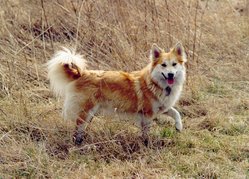
Iceland Dog
Íslenskur fjárhundur
Islandsk Farehond
Friaar Dog
Canis islandicus
|
From Wikipedia the free encyclopedia, by MultiMedia |
| Icelandic Sheepdog | ||
|---|---|---|

The Icelandic Sheepdog has a smooth gait.
|
||
| Alternative names | ||
| Icelandic Spitz Iceland Dog Íslenskur fjárhundur Islandsk Farehond Friaar Dog Canis islandicus |
||
| Country of origin | ||
| Iceland | ||
| Common nicknames | ||
| Classification and breed standards | ||
| FCI: | Group 5 Section 3 #289 | |
| AKC: | Herding (FSS) | |
| CKC: | Miscellaneous Class | |
| UKC: | Northern Breeds | |
| Not recognized by any major kennel club | ||
| This breed of dog is extinct | ||
| Notes | ||
| The CKC "miscellaneous class" is for breeds working towards full recognition by the CKC. | ||
The Icelandic Sheepdog is a breed of spitz dog originating from the dogs brought to Iceland by the Vikings. Later, dogs were taken from Iceland to the British Isles and became the basis for Border Collies and Corgis. In the Shetland Islands, it was crossed with the Norwegian Buhund and became the Shetland Sheepdog.
The Icelandic Sheepdog's distinct features are pointy ears and a curly tail. It is of medium height, and is commonly golden, reddish, black, or grey combined with white. The coat may be long or short.
Plague and canine distemper destroyed over 75% of the breed in the late 19th century, leading to a ban on the importation of dogs. The purebred Icelandic sheepdog was again bordering extinction in the late 20th century and in 1969 the Icelandic Dog Breeder Association (HRFÍ) was established, which had among other aims to preserve the breed.
The breed is sometimes denoted in Latin as canis islandicus even though it is a breed and not a species.
 The icelandic sheepdog often have double spurs on the hind paws.
The icelandic sheepdog often have double spurs on the hind paws.
Dogs, made by MultiMedia | Free content and software
This guide is licensed under the GNU Free Documentation License. It uses material from the Wikipedia.